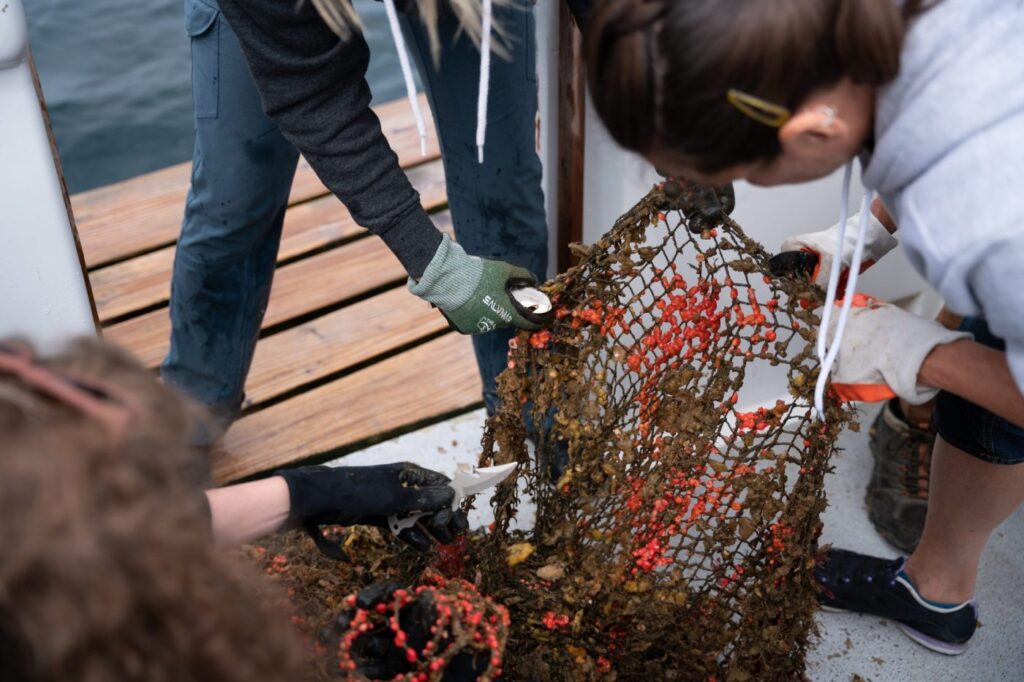
Volunteer divers spent time this week near a sunken pre-World War II destroyer, retrieving commercial fishing nets 150 feet under the sea off the coast of San Pedro as part of an international effort to clean the world’s oceans and protect marine life.
The team retrieved two lost nets that were stuck on the destroyer and would otherwise trap and kill sea animals — an effort for which the divers risked getting caught in the nets themselves.
The mission was the first effort undertaken in the United States by the international nonprofit Healthy Seas, partnering with the just-established U.S. chapter of Ghost Diving, which put together a team of six volunteer technical divers who specialize in removing lost fishing gear and other marine debris.
Healthy Seas estimates that 640,000 tons of fishing gear is lost, abandoned or discarded in the seas and oceans annually, getting stuck on shipwrecks and reefs, potentially remaining in the environment for hundreds of years while losing tiny particles called microplastics that end up in the food chain.
When those nets float freely in the sea, they are still fishing — catching fish, water birds and other marine animals without fishing boats ever bringing anything to surface.
That phenomenon is dubbed “ghost fishing.” The nets are made to appear invisible underwater as a way to trap fish. But when abandanoned, the nets will indiscriminately kill all types of marine animals, including turtles, fish, mammals and birds. Divers themselves can also get caught in the nets.
Ghost Diving and Healthy Seas are working to eliminate that.
Global nylon manufacturer Aquafil recycles the net fibers into yarn, swimwear, socks, carpets and more. Other partners also repurpose the material into bracelets and sunglasses.
Since its founding in 2013, Healthy Seas has collected more than 773 tons of fishing nets and other marine litter with the help of volunteer divers and fishers.
Ghost Diving, meanwhile, has worked 15 other countries, including New Zealand, Egypt, the Philippines and Portugal.
Two teams of up to three divers each were underwater Thursday, April 28, cutting nets from the ship for an hour and 30 minutes, said Norbert Lee, coordinator for the Ghost Diving’s U.S. chapter. A third team filmed the job.
After cutting the nets, the divers tied orange, air filled “lift bags” to them to make the nets rise to the ocean surface. Once they floated up, folks stationed on the boat pulled the nets onto the deck.
Thursday’s conditions were challenging, said Karim Hamza, who’s in charge of dive operations for Ghost Diving USA. They got the job done despite the boat-rocking waves, he added, but the divers could only see 10 feet below the “snot green” ocean surface once they entered the water.
“It blocked all sunlight,” Hamza said. “It was like diving at night.”
The crew had better visibility about 20 feet deep, he added, but the net removal quickly stirred up particles, making it hard to see and avoid obstacles again.
Net removal was tricky at the 150-foot depth, said Pascal Van Erp, coordinator of the Ghost Diving headquarters in the Netherlands, and on top of that, the crew had to cut steel wire to break the net free from a beam.
Only a few people can be down there at a time to keep them safe, Hamza said. If a diver is too close to a rising net, they could go up with it too fast and have an embolism.
Hamza trains the teams for these technical dives, he said; once volunteer applicants are approved, they join dives as observers then get prepped for the harder stuff, like Thursday’s job.
Thursday’s team staged off the San Pedro harbor at 7:30 a.m. and returned in the early afternoon. The sunken ship that they tore the nets from was the USS Moody, which was split into two pieces and sunk as part of the 1933 movie “Hell Below,” a World War I submarine thriller from MGM starring Robert Montgomery and Walter Huston.
Objects lost at sea — like the sunken ship — can attract the abandoned nets, van Erp said, and currents can easily wash fish into the nets.
“Since local fishermen may not know about the wreck, it is a huge obstacle that catches ghost nets from time to time,” said Christina Wiegers, project manager for Healthy Seas.
“The wreck is home to a few species of rockfish,” she added, “as they like rocky reef habitats and it provides a valuable nursery for them.”
Healthy Seas and Ghost Diving do this work to spread awareness of pollution in the ocean while trying to put a dent in the issue.
“We always try to document (the dives) because people don’t understand we have a problem underwater,” Hamza said.
“Marine pollution looks like (nothing) to the majority of people,” van Erp said. “People don’t see it like we (divers) do; we don’t only see plastic bags, but complete dumps.”
He added that 40% of plastic pollution in the ocean is lost fishing gear. But, van Erp said, he has also seen boat and car batteries, entire cars, bicycles, stoves and furniture underwater; the diving crews grab things like that too when they can.
“Eventually, marine life, fauna and flora,” Hamza said, “will start coming in as we clean up the nets.” That, Hamza said, will result in healthier reefs.
A few months of clean up may not look like much, he added, but real change can be seen after two or three years of net collection.
Future clean-up dive sites in Southern California could include the UB88, a German WWI submarine, Wiegers has said, as well as the Farnsworth Bank reef near Catalina Island.
